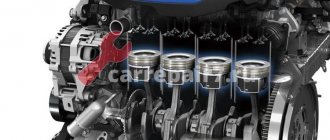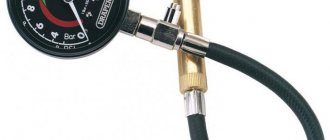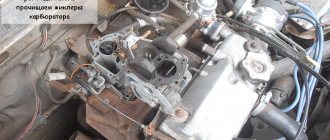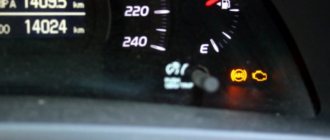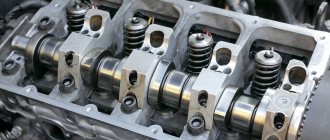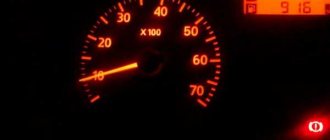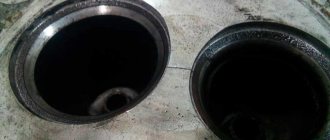If one of the cylinders completely refuses to work and the engine stalls, then during its operation you can hear the indignant grumbling of the engine. “Boo-boo-boo” means it’s time to see a specialist. Moreover, you should not postpone this visit, since the wear of the motor in this case will be much stronger than during normal operation. If the engine stalls, its compression is significantly reduced, and all the necessary conditions are present for scuffing to occur on the pistons and cylinders. In this case, the operating temperature of the engine increases significantly, and therefore it begins to overheat.
Without fully understanding all the nuances, it may seem that identifying such a malfunction is quite easy. But it also happens that the engine works absolutely normally, does not overheat and still starts to stall. In this regard, we will try to tell you point by point how to correctly diagnose and what you should first pay attention to in order to determine the cause of the engine tripping.
Spark plugs are to blame
Most likely, the cause of the engine tripping is the spark plugs. In order to verify this fact, you should unscrew the spark plug from the cylinder and carefully inspect it. If the engine is operating correctly, the color of the side electrode, as well as the insulator, will be quite light. A brown tint is also allowed. A spark plug in this condition should be fully functional. But if the carbon deposits on the candle turn out to be black, then it simply cannot be working. It is either enriched with fuel or filled with oil.
Due to carbon deposits formed on the spark plug, it may not work at all or only work occasionally. Both the first and second options interfere with the normal formation of a spark.
The reasons for the appearance of carbon deposits on candles may be:
- the car engine has been idling for a long time or has been warming up for a long time;
- there is reduced compression in the cylinder;
- valve timing is shifted or disturbed;
- the injector is not working correctly;
- The oxygen sensor is faulty.
Next, it is imperative to pay attention to the housing in which the spark plug itself is placed. It should be completely white, without black dots or stripes. If, nevertheless, stripes or dots are visible on the body, this indicates that the spark plug is breaking through normally, but will not work.
But if, after inspecting the spark plug housing, nothing of the kind was found, you should check the spark while cranking the starter. To do this, a spark is inserted into the tip of a high-voltage wire and placed on the engine ground. The engine is cranked by the starter. At this time, you need to see if a spark jumps between the two electrodes of the spark plug. If it is visible to the naked eye and has a pronounced blue color, the candle is working correctly.
Causes of engine tripping
On the one hand, engine tripping is a seemingly understandable reason for everyone, but in fact, tripping is (most often) just a consequence of some kind of malfunction.
Here we will look at the main causes of engine tripping, and accordingly, we will find ways to eliminate this headache. In this case, you need to start checking by identifying the non-working cylinder:
- To do this, start the engine and open the hood.
- We listen to the sound of the engine and remember it.
- We begin to pull out the high-voltage wires one by one.
- When we pull out the high-voltage wires, the corresponding cylinder stops working and the sound of the engine changes and begins to double. Our task is to find the wire that, when pulled out, will not change the sound of the engine, which means we will find a non-working cylinder.
Next, what we need to do is determine whether a spark is formed on the spark plug in a given cylinder or not, in order to determine in which direction we should move next.
Spark plug
We take a spark plug wrench and unscrew the spark plug, look at the condition of the electrode:
- brick color - indicates normal operation of the cylinder;
- smoked, with a little soot, etc. – indicates that the engine is not operating properly, either due to excess oil or too much fuel remaining.
Such deposits on the spark plug prevent it from working properly, creating a weak and irregular spark. Cleaning the spark plugs or replacing them will not help in this case, because... you need to look for the cause of the soot that appears: it could be
- malfunction of the non-return (exhaust) valve (needs to be adjusted - if it is clamped, replaced - if it is burnt out);
- low compression in the cylinders (at least 10-10-10-10) - measure the compression correctly, make the appropriate repairs - most likely either your rings are stuck or the valves are burnt out;
- displacement of the valve timing - here either the timing belt is not installed correctly, or it has jumped off - the belt must be removed and reinstalled with phase adjustment;
- the injectors are overfilled - they need to be changed (how to replace the injectors?);
- low pressure in the fuel system (how to check the pressure?);
- The oxygen sensor readings are incorrect - you need to replace it;
- Carbon deposits can also appear when the engine is idling for a long time, if the spark plug has a non-standard heat rating - such spark plugs need to be replaced.
Pay attention to the white spark plug body: if there are black dots or stripes on it, it means the spark plug is broken and needs to be replaced
How to check the spark on a spark plug?
Next, we need to check whether the spark plug gives a spark or not: to do this, we put a high-voltage wire on the unscrewed spark plug and place the metal body of the spark plug on the engine (make sure that the electrode does not touch the engine body). Then we ask the assistant to start the engine (turn the starter for 2-3 seconds), and at this moment we look to see whether a spark appears on the spark plug or not.
No spark or weak sparking
If a spark appears, then move the spark plug away from the mass by 1 cm and repeat the previous action again.
If the spark has noticeably weakened and is barely visible, then we have poor sparking.
Poor spark formation or no spark at all may be caused by the following faults:
- Reasons why the 16-valve priors engine triples. nothing new
- high resistance of high-voltage wires, or wire breakage;
- To do this, you need to check the high-voltage wires and replace them (the high-voltage wires may not be installed correctly);
- ignition module malfunction - check and replace;
- ECU malfunction - have it repaired or replace it with a new one;
- DPKV malfunction - its malfunction will be indicated by an error that can be read using the BC or carried out diagnostics. A non-working sensor needs to be replaced;
- again, the timing belt could have slipped a couple of teeth - disassemble it and reinstall it according to the timing marks.
If there is a spark, and a good one, then all that remains is to look at the rings, compression, valves, injectors, which have already been described above. We wish you good luck in finding your problem!
Engine misfires when cold or hot
In this problem, valves are most often the cause: every 20 thousand km. valve clearances need to be adjusted. The bottom line is that if your engine stalls when cold, then the gap is apparently too large, then the engine heats up - the gap decreases, and engine operation returns to normal. The situation is the same with the engine stalling when hot, but vice versa: when it’s cold, the gap is normal, but when it’s hot, the valve is clamped and the engine starts to stall.
On the Internet it is often recommended to change spark plugs and high-voltage wires for this problem, but I would not advise you to simply waste money and buy something at random without understanding it.
The VAZ 2114 engine is shaking and misfiring, the check light is on (diagnosis and repair)
Inspection of high voltage ignition wires
If it turns out that the spark plugs are in perfect order, this most likely means that the problem lies in the high-voltage wires.
In order to test this theory, it is necessary to consider each wire separately. First of all, you should pay attention to the tip of the wire that is inserted into the spark plug. It should be completely monochromatic and not have any plaque on it. The presence of foreign scale on it indicates that for some time this high-voltage wire worked in extreme mode. If this problem is not corrected in time, the wire may subsequently break, which will lead to much more serious problems and costs.
The cause of a stalled engine is the spark plugs
In 50% of cases, the problem is due to the fact that the spark plugs simply do not produce a spark. This failure occurs as a result of 3 reasons:
- contacts become clogged;
- plaque forms along the entire contour of the candle;
- malfunction when supplying voltage to the spark plug.
However, the most popular is still black carbon deposits on the spark plugs, which prevents the spark from appearing or causes it to work periodically.
Tip: if the spark plug set malfunctions, you will hear a “triple” sound that is uncharacteristic of the engine. In this case, the car will jerk strongly while moving. As a result, the engine will either stall on its own, or you will need to turn it off and turn the ignition on again.
If you see dirt on the surface of the contacts, this indicates the need to replace a low-quality type of fuel or check the serviceability of the oil supply systems. It is the oil supply adjustment sensors that can splash the spark plugs with it if there is a problem. Also, oil that appears on a set of spark plugs may indicate serious damage to components in the engine cylinders. Be sure to check the engine at a car service center. Otherwise, further operation may lead to expensive replacement of jet rods and even the entire set of pistons.
If you systematically use low-quality gasoline samples, you may find a red-brown coating on the contour of the spark plug. In this case, cleaning will not help - it is better to immediately replace the entire set after a new refill. If you find that the car periodically turns off at full speed, but starts easily even with clean spark plugs, then the problem lies in the electrical wiring.
Injector malfunction
Trouble the VAZ-2115 engine? This may be due to faulty injectors. This happens if:
- the injector is faulty (this is quite rare);
- low-quality fuel is used;
- injectors require cleaning;
- The power or control circuits to the injector are shorted or completely broken.
If one of the sensors does not work, an error will appear on the dashboard, which will serve as a kind of scanner. But if the error does not appear, then the problem lies precisely in the mechanical part.
And it also happens that it is simply not possible to find the reason why the engine is tripping. In this case, it is necessary to use computer diagnostics of the car, after which the cause of the tripping will become completely clear. As a rule, a motor malfunction of this kind can only be detected by a specialist. Therefore, it is best to contact professional service centers. This will help save both time and your own money.
Conclusion
It has been determined that the reason why the VAZ 2115 engine fails is the lack of one of the important elements: fuel, spark or air. It was also found that a VAZ may stall when cold due to a malfunction of sensors, such as the idle air control.
Engine trouble is nothing more than a malfunction. Indicates a malfunction that one/several cylinders of the power unit are not functioning. As a result, the combustion process of the fuel assembly is disrupted, which affects the unstable functioning of the motor under load and in transient conditions.
Why did the engine start to stall? – The most complete analysis of the reasons
What does the term “Engine Troit” mean? I ask this question at the beginning of the article in order to cut off the “couch experts”, and only real car enthusiasts who love and appreciate their car remain here.
Just one of the commentators began to assert:
“Engine tripping is when there is no one cycle in the operation of an internal combustion engine. That is, out of four cycles of engine operation, one cycle was thrown away.”
I explained to him that he was wrong, but he didn’t get it. To prevent such armchair army specialists from wasting their time and “cracking” in the comments, I want to cut them off right away.
Why the car engine started to stall - the most common reasons
Now let's continue the conversation with real car lovers.
Today we will look at the main reasons why the motor may trip. They may seem banal, but read my work to the end carefully, I am sure you will learn something new for yourself.
Reason one - spark plugs
I wrote in detail about how to determine faults in car systems using spark plugs here .
I recommend reading it - it turned out to be useful, judging by your reviews, thank you.
We unscrew the spark plugs one at a time and look at their insulator. If it is covered with dense carbon deposits, then it is difficult for a spark to penetrate it. The current seeks the path with the least resistance, so the spark will not be between the electrodes, but will “go” along the insulator to the side. Its energy will not be enough to set fire to the air-fuel mixture. This cylinder will not work.
Heavy carbon deposits on the spark plug electrodes may cause the engine to trip.
We inspect the external condition of the spark plug insulator. If there are microcracks, then part of the current will not be converted into a discharge, but will escape through these damages. You need to look at the internal insulator, which is screwed into the cylinder head, and at the external one, onto which the armor wire cap is placed.
Any chips or damage can lead to poor sparking or its complete absence.
A superficial breakdown of the spark plug insulator is one of the reasons why the engine began to fail.
A large or small gap between the electrodes. Many people have heard or know that for certain engines, ignition systems and types of fuel used, spark plugs with a certain gap are required. Usually its value is indicated by the manufacturer of engines and cars.
In order for the spark plug to work well and the engine not to stall, a certain gap between its electrodes is needed
How to check the spark without special devices on the engine
This is an old, “grandfather” method, some people are afraid of it:
- They unscrewed the spark plug;
- They put an armored wire on her;
- They leaned it with the inner body, the metal part, against the engine;
- Turn on the ignition and turn the starter.
Be sure to hold on to the rubber cap of the armored wire, otherwise your hand will shake violently. This is what many are afraid of


